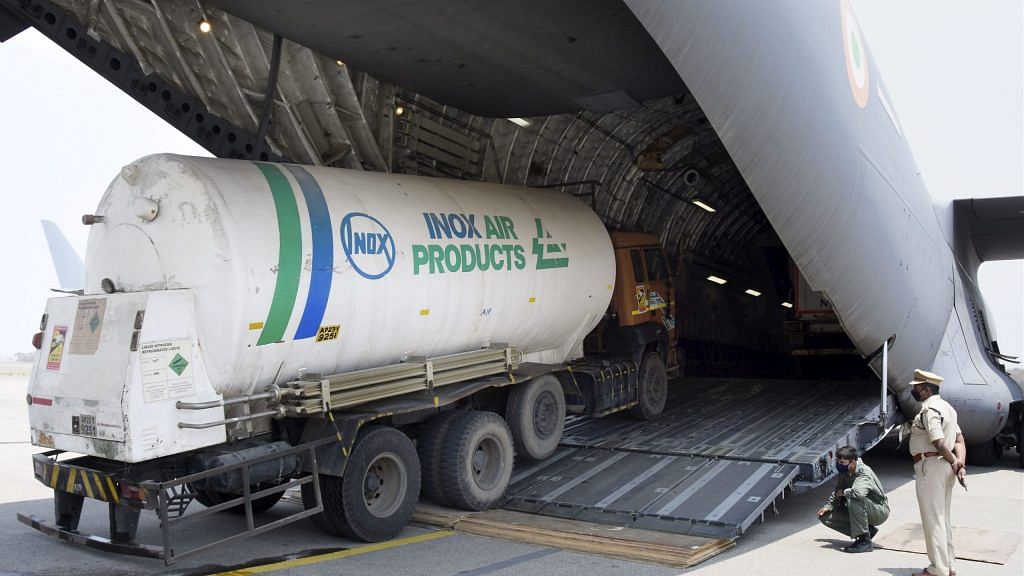The armed forces have been called in again to assist the civil administration in the Covid-19 crisis – they have performed before, and they will do it again this time too. The expertise, dedication, chain of command and control, and belief in leadership will carry them through. This brings to fore the impressive inherent capabilities for Humanitarian Assistance and Disaster Relief, or HADR, that our forces possess; fulfilling India’s both internal and external needs, HADR is a major cog in military diplomacy. In this endeavour, the Indian Air Force is ideally suited where time and speed are of essence.
As part of its Covid-19 missions so far, the Indian Air Force (IAF) has been ferrying empty oxygen tankers to places that have factories producing this life-sustaining element that is currently in short supply; they have also flown-in cryogenic containers from Singapore. If they could, they would have ferried back filled containers too, but technical and flight safety limitations do not permit that. Earlier, Covid testing kits and samples were flown from remote places and islands. Is this the first time that the IAF has undertaken such a unique task? Certainly not.
Also read: Emergency financial powers to tenure extension of SSC doctors — how MoD is aiding Covid fight
Always to the rescue
After the Bhopal gas tragedy of 1984, the IAF was called upon to sprinkle water on Union Carbide tanks containing deadly chemicals that had caused widespread misery to the inhabitants around the factory. Mi-8 helicopters were modified with water tanks and spray pumps for the task of cooling the tanks. Last year, when India was hit by a locust deluge, a Mi-17 was modified for spraying environment-friendly insecticides. Earlier, as part of the conservation effort Project Tiger, a few wild cats were translocated by helicopters between wildlife parks.
Then there are the more off-beat entreaties. During my time as Assistant Chief of Air Staff a decade ago, I oversaw operations of transport and helicopters. There was once a request to airlift a huge mural of an accomplished artist to a museum in the Northeast. The request letter sang paeans of the IAF and said, “surely, the IAF could do this small favour in the interest of the nation – for free of course!” The task would have required an IL-76, considering the dimensions of the framed artefact. Obviously, the request was politely declined, however, it conveyed a larger point — how Indians put their faith in their country’s air force.
Also read: Army stresses on integrated logistics on the lines of Amazon, Flipkart amid Covid crisis
IAF’s capabilities, India’s assets
The IAF has the nation’s hard power assets for conducting such ‘soft power’ tasks. With eleven C-17 Globemasters that can airlift up to 70 tonnes each, around a similar number of IL-76 (40 tonnes payload), twelve C-130 Super Hercules and almost 90 An-32s, the IAF’s capabilities are substantial.
These aircraft would have been flogged the past year for the massive airlift of the Indian Army that took place in the Eastern Ladakh crisis — and would continue to be heavily utilised in the coming months to sustain the increased number of troops there. The helicopter fleet, too, is impressive with almost 200 plus Mi-series medium lift helicopters, 50-odd Dhruv Advanced Light Helicopters, and the fifteen new heavy lift Chinooks. With the thrust on accelerated development of border infrastructure and the increased Army deployments there, the rotary wing fleet can also be expected to be heavily tasked. Both these fleets will need careful handling and nurturing as they are heavily dependent on foreign entities for maintenance spares and overhaul support.
The IAF has been through maintenance crises because of this dependence in the past. The first instance was in the 1990s, when the Cold War ended and the USSR collapsed. Many fleets, including those of fighter aircraft, saw a drastic reduction in availability of aeroplanes on the flight lines. Another crisis was after the 1998 nuclear tests, when the Indian Navy’s Sea King fleet came to a grinding halt due to sanctions imposed by the United States. We now have a significant number of aircraft from the US too, besides those from Russia, and have to tread a careful and tenuous path in our relations to ensure that our operational capability is not affected.
A reduction in op capability, politicians and decision makers may well like to remember, will not only affect India’s war waging potential but its HADR capabilities too – vitally important for soft power. The Covid-19 pandemic is not going to end anytime soon, nor are the other natural calamities that have started affecting India with greater ferocity and frequency.
One way to have adequate number of serviceable aircraft on the flight lines could be to relook at the necessity of ceremonial fly pasts and showmanship, and resume them when things improve. Another way could be to double down on India’s road connectivity projects to forward areas so as to reduce the air maintenance task for the Army, thereby saving substantial flying hours of these vital aerial assets; handing over certain air maintenance tasks to civil operators to reduce the load on IAF fleets, has been debated often and could be revisited. The IAF’s transport and helicopter assets are our ‘crown jewels’ and need careful husbanding.
The author is Additional Director General, Centre for Air Power Studies, New Delhi. Views are personal.
